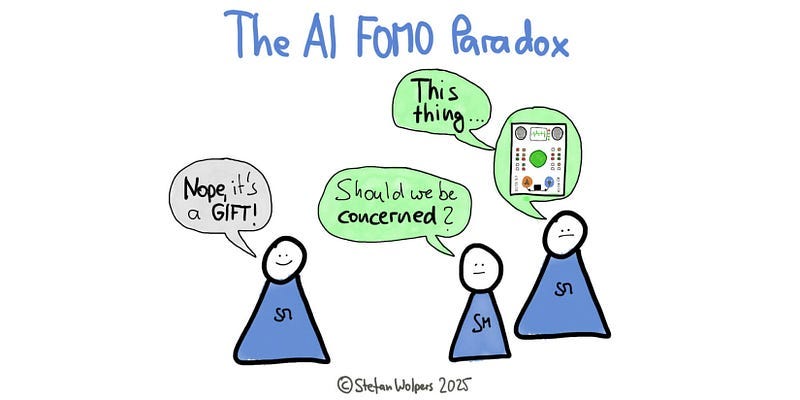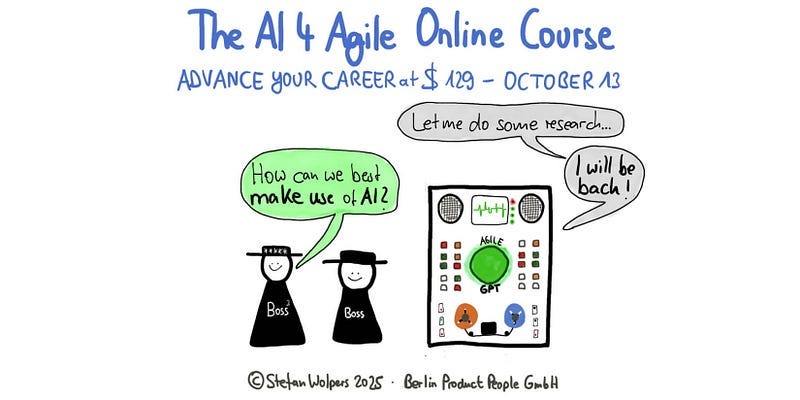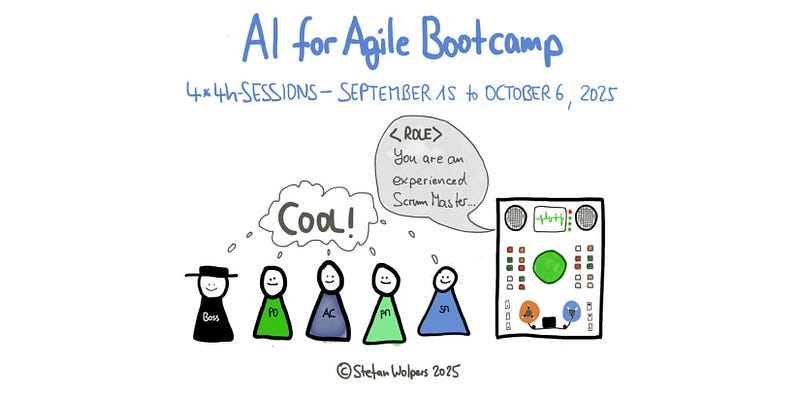Hello everyone!
AI FOMO comes from seeing everyone’s polished AI achievements while you see all your own experiments, failures, and confusion.
The constant drumbeat of AI breakthroughs triggers legitimate anxiety for Scrum Masters, Product Owners, Business Analysts, and Product Managers: “Am I falling behind? Will my role be diminished?”
But here’s the truth: You are not late. Most teams are still in their early stages and uneven. There are no “AI experts” in agile yet — only pioneers and experimenters treating AI as a drafting partner that accelerates exploration while they keep judgment, ethics, and accountability.
Disclaimer: I used a Deep Research report by Gemini 2.5 Pro to research sources for this article.
🎓 🇬🇧 🤖 The AI 4 Agile Online Course at $129 — October 13, 2025
I developed the self-paced AI 4 Agile Online Course for agile practitioners, including Product Owners, Product Managers, Scrum Masters, Agile Coaches, and delivery professionals who want to integrate artificial intelligence into their workflows with clarity, ethics, and purpose.
You don’t need to become an AI expert. However, you do need to understand how LLMs like ChatGPT, Claude, or Gemini can support real agile work and where their limitations lie. Like Jim Highsmith said, AI isn’t just a tool, but a new context for agility.
This course shows you how to do precisely that.
What’s Included:
10+ hours of self-paced video modules
A cohort-hardened, proven course design
Learn to 10x your effectiveness with AI; your stakeholders will be grateful
Delve into classic agile use cases of AI
Help your team create more customer value
All texts, slides, prompts, graphics; you name it
Access custom GPTs, including the “Scrum Anti-Patterns Guide GTP”
Enjoy community access for peer learning
Guaranteed: Lifetime access to all course updates and materials; there is a lot more to come
Certificate of completion.
👉 Please note: The course will only be available for sign-up at $129 until October 20, 2025! 👈
🎓 Join the Waitlist of the AI 4 Agile Online Course Now: Master AI Integration for Agile Practitioners — No AI Expertise Required!
The Reality Behind the AI Success Stories
Signals are distorted: Leaders declare AI-first while data hygiene lags. Shadow AI usage inflates progress without creating stable practices. Generative AI has officially entered what Gartner calls the “Trough of Disillusionment” in 2024–2025 (Source: Gartner AI Hype Cycle Report). MIT Sloan’s research reveals only 5% of business AI initiatives generate meaningful value (Source: AI FOMO, Shadow AI, and Other Business Problems. Note: The MIT Sloan report needs to be handled with care due to its design.)
Companies spend an average of $1.9 million on generative AI initiatives. Yet, less than 30% of AI leaders report CEO satisfaction (Source: AI Hype Cycle — Gartner Charts the Rise of Agents, HPCwire). Meanwhile, individual workers report saving 2.2–2.5 hours weekly (Source: Impact of Generative AI on Work Productivity, Federal Reserve Bank of St. Louis) — quiet, durable gains beneath the noise generated by the AI hype.
The “AI Shame” phenomenon proves the dysfunction: 62% of Gen Z workers hide their AI usage, 55% pretend to understand tools they don’t, with only a small fraction receiving adequate guidance (Source: AI Shame Grips the Present Generation, Times of India). This isn’t progress; it’s organizational theater.
Good-Enough Agile Is Ending
AI is not replacing Agile. It’s replacing the parts that never created differentiated value. “Good-Enough Agile,” teams going through Scrum events without understanding the principles, is being exposed. Ritualized status work, generic Product Backlog clerking, and meeting transcription: all becoming cheap, better, and plentiful.
Research confirms AI as a “cybernetic teammate” amplifying genuine agile principles (Source: Generative AI & Agile: A Strategic Career Decision, Scrum.org). The Agile Manifesto’s first value, “Individuals and interactions over processes and tools,” becomes clearer. AI is the tool. Your judgment remains irreplaceable.
The AI for Agile anti-patterns revealing shallow practice include:
Tool tourism: Constant switching that hides a weak positioning.
Hero prompts: One person becomes the AI bottleneck instead of distributing knowledge.
Vanity dashboards: Counting prompts instead of tracking outcome-linked metrics.
Automation overreach: Brittle auto-actions that save seconds but cost days.
These patterns expose teams practicing cargo cult Agile. Career insecurity triggers documented fears of exclusion (Source: Fear of Missing Out at Work, Frontiers in Organizational Psychology; the link downloads an e-pub.), but the real threat isn’t being excluded from AI knowledge. It’s being exposed as having practiced shallow Agile all along. (Throwing AI at a failed approach to “Agile” won’t remedy the main issue.)
The Blunt Litmus Test
If you can turn messy inputs into falsifiable hypotheses, define the smallest decisive test, and defend an ethical error budget, AI gives you lift. If you cannot, AI will do your visible tasks faster while exposing absent value and your diminished utility from an organization’s point of view.
Your expertise moves upstream to framing questions and downstream to evaluating evidence. AI handles low-leverage generation; you decide what matters, what’s safe, and what ships.
🖥 💯 🇬🇧 AI for Agile BootCamp Cohort #2 — September 15 — October 6, 2025
The job market’s shifting. Agile roles are under pressure. AI tools are everywhere. But here’s the truth: the Agile pros who learn how to work with AI, not against it, will be the ones leading the next wave of high-impact teams.
So, become the one who professional recruiters call first for “AI‑powered Agile.” Be among the first to master practical AI applications for Scrum Masters, Agile Coaches, Product Owners, Product Managers, and Project Managers.
Tickets also include lifetime access to the corresponding online course, once it is published. The class is in English. 🇬🇧
Learn more: 🖥 🇬🇧 AI for Agile BootCamp Cohort #2 — September 15 — October 6, 2025.
Customer Voice: “The AI for Agilists course is an absolute essential for anyone working in the field! If you want to keep up with the organizations and teams you support, this course will equip you with not only knowledge of how to leverage AI for your work as an Agilist but will also give you endless tips & tricks to get better results and outcomes. I thoroughly enjoyed the course content, structure, and activities. Working in teams to apply what we learned was the best part, as it led to great insights for how I could apply what I was learning. After the first day on the course, I already walked away with many things I could apply at work. I highly recommend this course to anyone looking to better understand AI in general, but more specifically, how to leverage AI for Agility.” (Lauren Tuffs, Change Leader | Business Agility.)
Practical Leverage Points
There are plenty of beneficial approaches to employing AI for Agile, for example:
Product Teams: Convert qualitative inputs into competing hypotheses. AI processes customer transcripts in minutes, but you determine which insights align with the Product Goal (Source: Generative AI & Agile: A Strategic Career Decision, Scrum.org). Then, validate or falsify hypotheses with AI-built prototypes faster than ever before.
Scrum Masters: Auto-compile WIP ages, handoffs, interrupting flow, and PR latency to move Retrospectives from opinions to evidence. AI surfaces patterns; you guide systemic improvements (Source: Artificial Intelligence in Agile, Sprightbulb). Seriously, talking to management becomes significantly easier once you transition from “we feel that…” to “we have data on…”
Developers: Generate option sketches, then design discriminating experiments. PepsiCo ran thousands of virtual trials; Wayfair evolved its tool through rapid feedback — AI accelerating empirical discovery (Source: AI & Agile Product Teams, Scrum.org).
Stanford and World Bank research shows a 60% time reduction on cognitive tasks (Source: Productivity Gains from Using AI, Visual Capitalist). But time saved means nothing without judgment about which tasks matter. Building useless things more efficiently won’t prove your value as an agile practitioner to the organization, when serious voice question your effectivness.
Conclusion: From Anxiety to Outcome Literacy
The path forward isn’t frantically learning every tool. Start with one recurring problem. Form a hypothesis. Run a small experiment. Inspect results. Adapt. This is AI for Agile applied to your development.
The value for the organization shifts from execution to strategic orchestration (Source: Human + AI: Rethinking the Roles and Skills of Knowledge Workers, AI Accelerator Institute). Your experience building self-managing teams becomes more valuable as AI exposes the difference between genuine practice and cargo cult Agile. Durable wins come from workflow redesign and sharper questions, not model tricks. If you can frame decisions crisply, choose discriminating tests, and hold ethical lines, you’re ahead where it counts.
AI FOMO recedes when you trade comparison for learning velocity. Choose an outcome that matters, add one AI-assisted step that reduces uncertainty, measure honestly, and keep what proves worth. AI won’t replace Agile; it will replace Good-Enough Agile, and outcome-literate practitioners will enjoy a massive compound advantage. It helps if you know what you are doing for what purpose.
Food for Though on AI FOMO
How might recognizing AI as exposing “Good-Enough Agile” rather than threatening genuine practice change your approach to both AI adoption and agile coaching in organizations that have been going through the motions?
Given that AI makes shallow practice obvious by automating ritual work, what specific anti-patterns in your organization would become immediately visible, and how would you address the human dynamics of that exposure?
If the differentiator is “boring excellence” — clean operational data, evaluation harnesses, and reproducible workflows — rather than AI tricks, what foundational practices need strengthening in your context before AI can actually accelerate value delivery?
📖 AI FOMO — Related Posts
Meta Prompting: Making AI Your Conversation Partner
Ethical AI in Agile: Four Guardrails Every Scrum Master Needs to Establish Now
Generative AI in Agile: A Strategic Career Decision
Contextual AI Integration for Agile Product Teams
👆 Stefan Wolpers: The Scrum Anti-Patterns Guide (Amazon advertisement.)
📅 Training Classes, Meetups & Events 2025
Upcoming classes and events:
🖥 💯 🇬🇧 September 15–October 6 — Live Virtual Cohort: AI for Agile BootCamp Cohort (English)
🖥 💯 🇬🇧 October 1–November 12 — Live Virtual Cohort: AI for Agile BootCamp Cohort (English)
🖥 💯 🇩🇪 October 21–22 — Live Virtual Class: Professional Scrum Product Owner Training (PSPO I; German)
🖥 💯 🇬🇧 November 6-December 4 — Live Virtual Cohort: AI for Agile BootCamp Cohort (English)
🖥 🇬🇧 November 10–11 — Live Virtual Class: Professional Scrum Master — Advanced Training (PSM II; English)
🖥 🇩🇪 November 17–18 — Live Virtual Class: Professional Scrum Product Owner Training (PSPO I; German)
🖥 🇩🇪 December 9–10 — Live Virtual Class: Professional Scrum Product Owner Training (PSPO I; German)
🖥 🇬🇧 December 16–17 — Live Virtual Class: Professional Scrum Master — Advanced Training (PSM II; English)
🖥 🇬🇧 December 18 — Live Virtual Class: Professional Scrum Facilitation Skills Training (PSFS; English)
👉 See all upcoming classes here
📺 Join 6,000-plus Agile Peers on YouTube
Now available on the Age-of-Product YouTube channel:
Hands-on Agile #68: How to Analyze Unstructured Team Interview Data with AI.
Hands-on Agile 2025: The 5 Obstacles to Empowered Teams — Maarten Dalmijn
Hands-on Agile 2025: The Top Reasons Why a Product Strategy Fails — Roman Pichler
Hands-on Agile 2025: Taylorism-Lean-Agile-Product Mindset — Jonathan Odo
Hands-on Agile Extra: How Elon Musk Would Run YOUR Business mit Joe Justice
🎓 Do You Want to Read More Like This?
Also:
📅 Join 6,000-plus peers of the Hands-on Agile Meetup group
🐦 Follow me on Twitter and subscribe to my blog, Age of Product
💬 Alternatively, join 20,000-plus peers of the Slack team “Hands-on Agile” for free.






